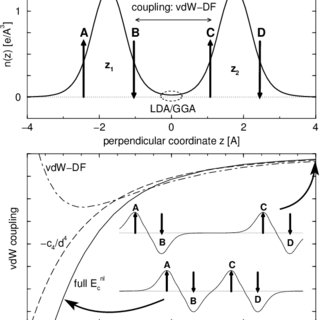The outcomes of the Kohn-sham and Hohenberg disclosed that ground state energy could be obtained by attaining the minimum energy of an energy functional and it could be executed through the discovery of a self-consistent solution to a set of one particle equations. Which could be attained only by solving the Kohn-sham equation, an exchange-correlation function i.e. and this might be done by explicitily writing their parts. Actually the exchange correlation functions notify about almost all types of quantum mechanical interaction in between the electronic densities. There are several functional that are utilized in the DFT such as LDA, GGA, meta-GGA, Hybrid Functional, dispersion functional. The choice of functional are based on the material and the accuracy of the functional is decided on the basis of Jacob’s Ladder.

In Local density approximation (LDA), the density of electron gas is constant throughout the environment and applicable for the systems where the movement of the particles fluctuate steadily within the electron gas. However, LDA overbinds the molecules and underestimates the band gaps of insulators as well as the semiconductors upto 40%. This underestimation of band gap is expected from unknown accurate/exact potential of the DFT due to the discontinuity of exchange correlation energy. The generalized gradient approximation (GGA) considers the gradient of the electron gas and calculate the electron density to a specific region. It also underestimates the band gaps but it predicts the energy trends well for various materials so taken into consideration. Several extensions of the GGA has been introduced that includes the PBE, PBE-sol, PW-91 and so on. In contrast to LDA, this approximation is more precise and errors are remarkably decreased.
The solution of Kohn-Sham equation under LDA. considered as the appropriate method to compute the structural characteristics close to the equilibrium inter-layer distance of systems such as graphite as well as h-BN. Also, the more detailed XC functional GGA fails drastically to describe the interlayer distance in graphene as well as in h-BN although a complete description of the covalent bonding is given by this method. The main drawback of the mostly utilized functional (i.e. LDA & GGA) is that it does not properly describe the non-local electronic correlation impacts e.g. vdWs interactions. This is because of the absence of the elucidation of the van der Waals interaction that are the demonstration of long range correlation impacts. For layered two dimensional materials that includes the strong in-pane covalent bonding and weak van der Waals interactions. The explanation of these systems must incorporate an exact investigation of the full range of interactions from the small range covalent bonding towards the long range vdWs forces.
Generally, the addition of the van der Waals based DFT method could be categorized into two types. One includes the approach established on the semi-empirical amendments usually accompanied by the dispersion corrections of the Kohn sham energy and the other includes a non-local DFT that directly change the Hamiltonian of Kohn sham. The initiation of the dispersion methodology, entitled as DFT-D and DFT-D2.that utilizes the constant values of the coefficients “” for every chemical family. These estimation does not include the impact of several hybridization states or oxidation of the similar element. Hence, more advancement in coefficient
based on the environment of the chemical has been established to such methods. The DFT-D3 technique, as proposed by the Grimme et al., involve the coefficients based on the environment by considering the number of adjacent atoms that each atom possess. A different technique as proposed by the Tkatchenko and Scheffler, which established the
coefficients on new scale by considering reference atomic “
” coefficients, reference atomic polarizability as well as the effectual atomic volumes attained by dividing the total density of electrons of the system b/w the single atoms utilizing the “Hirshfeld partitioning scheme”.
